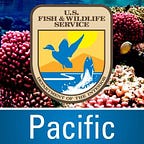Saving a Seabird Paradise From Invasive, Acid Spraying Ants
By: Ivan Vicente, Public Affairs Officer, U.S. Fish and Wildlife Service
Seabirds that nest on the isolated islands and atolls of the Pacific evolved without predators. They nest mostly on the ground, in burrows, or in the low-lying native plants like naupaka. This makes them incredibly vulnerable to introduced species like cats, rats, and mice…and the smallest invader — ants.
Johnston Atoll National Wildlife Refuge is one of the most isolated atoll formations in the world, providing essential habitat to tens of thousands of seabirds for feeding, nesting, and resting.
For over 10 years, these seabirds were severely threatened by one of the tiniest and most notorious invaders in the world — the yellow crazy ant. Likely brought to the island by humans, the ant quickly spread and caused devastation. Swarming over the ground nesting seabirds and their chicks, the ants spray formic acid on the birds — causing injury, deformities, and infection that can lead to death.
After combating yellow crazy ants for nearly a decade, U.S. Fish and Wildlife Service volunteers and staff have successfully eradicated the notorious invaders at Johnston Atoll National Wildlife Refuge.
The 640 acre refuge sustains the world’s largest colony of red-tailed tropicbirds, with nearly 13,000 nesting pairs counted by Service volunteers and biologists in 2021. This is the only terrestrial seabird habitat in over 570,000 square miles of open ocean, with fifteen species of breeding seabirds relying on this refuge — part of the Pacific Remote Islands Marine National Monument.
The arrival and rapid spread of YCA on Johnston Island prior to their discovery in 2010, effectively precluded all Red-tailed Tropicbird nesting in the 70 acre infestation area, also affecting other seabirds by spraying formic acid on chicks and adults — causing blindness, injury and death.
The USGS scientists at Pacific Islands Ecosystems Research Center (PIERCE) were invited to join the CAST project to provide technical guidance in 2014. Their involvement marked the turning point for the eradication project, shifting the Service efforts by using their recommended hydro-gel crystals that delivered the efficient eradication treatment.
This is the first time an invasive ant species has been eradicated on such a large land area in the U.S. The successful YCA eradication from Johnston Atoll NWR resulted from the dedicated work of nearly 100 staff and volunteers divided in 20 separate crazy ant strike team (CAST) crews , collectively devoting over 130,000 field hours over a span of 10 years.
The battle against yellow crazy ants at Johnston Atoll required creativity and ingenuity as crews experimented to find the best way to bait and eradicate the ants. After these bait treatments the crews hand-searched the island multiple times to find remove any remaining ants.
Two conservation detection dogs trained to sniff out yellow crazy ants were brought to the refuge in December 2020 to help with this process. The dogs surveyed 118 total miles without detecting a single ant, providing greater confidence that the ant has indeed been eradicated.
The success at Johnston Atoll National Wildlife Refuge could provide a roadmap for other conservation managers dealing with invasions of yellow crazy ants in other protected areas.
While the mission of CAST is complete, the Service still has much conservation work to be done at Johnston Atoll. The Service will continue to focus on conserving and protecting the refuge, managing other invasive species, and restoring habitat. For now, Johnston Atoll has an ensured future for its native wildlife, reinstated as a safe haven for its amazing seabirds.
The U.S. Fish and Wildlife Service works with others to conserve, protect, and enhance fish, wildlife, plants, and their habitats for the continuing benefit of the American people. For more information, connect with us through any of these social media channels at https://www.facebook.com/PacificIslandsFWS, www.flickr.com/photos/usfwspacific/, or www.twitter.com/USFWSPacific.
